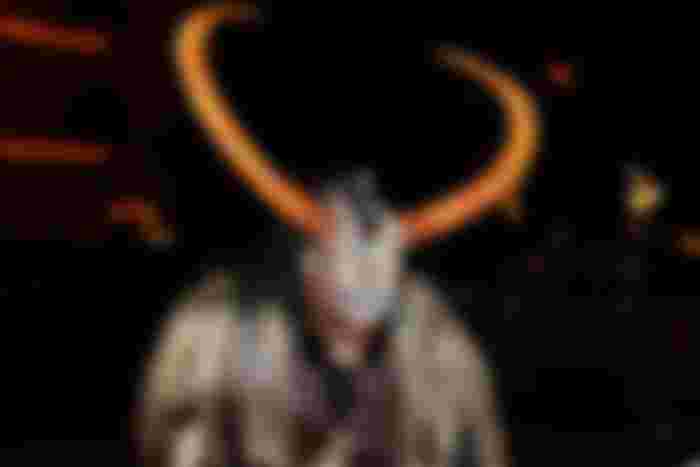WHEN LISTENING TO the radio in December, it's probably not going to hear occasion melodies singing the gestures of recognition of Krampus: a half-goat, half-evil spirit, awful monster who truly beats individuals into being decent and not underhanded.
The legend of the Krampus goes back hundreds of years, beginning as a German Christmas convention during the twelfth century. Starting toward the beginning of December, the offspring of Germany would start to hear murmurs of a dim haired animal bearing horns and teeth, conveying a heap of birch sticks used to smack shrewd youngsters. As indicated by conventional accounts of Alpine fables, the Krampus would enter the towns, lashing his chains and ringers, to catch the awful kids in a bin and bring them down to the hidden world. The Krampusnacht (Krampus Night) would happen the night prior to December sixth (St. Nicholas Day), when the pleasant German youngsters were remunerated with presents in their boots.

Krampus isn't actually the stuff of dreams: Bearing horns, dull hair, teeth, and a long tongue, the counter St. Nicholas accompanies a chain and ringers that he lashes about, alongside a heap of birch sticks intended to smack devious youngsters. He at that point pulls the awful children down to the hidden world.
In Catholicism, St. Nicholas is the supporter holy person of youngsters. His holy people day falls toward the beginning of December, which fortified his relationship with the Yuletide season. Numerous European societies not just invited the benevolently man as a figure of liberality and kindheartedness to compensate the great, yet they additionally dreaded his threatening partners who rebuffed the terrible. Portions of Germany and Austria fear the brutal Krampus, while other Germanic districts have Belsnickle and Knecht Ruprecht, dark whiskery men who convey changes to beat youngsters. France has Hans Trapp and Père Fouettard. (A portion of these partners, for example, Zwarte Piet in The Netherlands have pulled in ongoing debate.)
Krampus' name is gotten from the German word krampen, which means paw, and is supposed to be the child of Hel in Norse folklore. The incredible monster additionally shares attributes with other unnerving, evil animals in Greek folklore, including satyrs and fauns.
The legend is important for a centuries-old Christmas convention in Germany, where Christmas festivities start toward the beginning of December. Krampus was made as a partner to merciful St. Nicholas, who compensated youngsters with desserts. Krampus, conversely, would smack "underhanded" kids, stuff them in a sack, and remove them to his sanctuary.

As indicated by fables, Krampus purportedly appears in towns the evening of December 5, known as Krampusnacht, or Krampus Night. The following day, December 6, is Nikolaustag, or St. Nicholas Day, when youngsters look outside their entryway to check whether the shoe or boot they'd forgot about the prior night contains either presents (a compensation for good conduct) or a bar (terrible conduct). (For additional on the historical backdrop of St. Nicholas, see From St. Nicholas to Santa Claus.)
A more present day take on the convention in Austria, Germany, Hungary, Slovenia, and the Czech Republic includes smashed men dressed as villains, who assume control over the roads for a Krampuslauf—a Krampus Run of sorts, when individuals are pursued through the roads by the "fallen angels."
Members dressed as the Krampus animal walk the roads looking for delinquent youngsters on November 30, 2013 in Austria.
Cheerful—or not really joyful—Krampus! This monster with Germanic roots is… Read More
Why alarm kids with an evil, agnostic beast?
Possibly it's a path for people to connect with their bestial side. Such motivations might be tied in with expecting "a double character," as per António Carneiro, who addressed National Geographic magazine about renewed agnostic conventions. The individual dressed as the monster "gets puzzling," he said.
Krampus is coming to town
Krampus' alarming presence was stifled for a long time—the Catholic Church denied the boisterous festivals, and extremists in World War II Europe discovered Krampus wretched in light of the fact that it was viewed as a making of the Social Democrats.

Be that as it may, Krampus has been having a resurgance in the course of recent years, because of a "bah, fake" mentality in mainstream society, with individuals looking for approaches to praise the yuletide season in non-conventional ways. In the United States, individuals are grasping the clouded side of Christmas with Krampus motion pictures, extraordinary "Krampus" TV scenes. They're tossing Krampus parties, going to neighborhood Krampusnachts (in urban areas like Washington, D.C. furthermore, New Orleans), and running in Krampus-themed races. (Peruse "How Krampus, the Christmas 'Fallen angel,' Became Cool.")
As far as it matters for its, Austria is endeavoring to popularize the brutal persona of Krampus by selling chocolates, puppets, and collectible horns. There are as of now grumblings that Krampus is getting excessively popularized and losing his edge as a result of his freshly discovered notoriety.



ভালোই ত আয় করছো